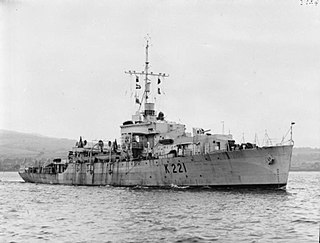
The Flower-class corvette was a British class of 294 corvettes used during World War II by the Allied navies particularly as anti-submarine convoy escorts in the Battle of the Atlantic. Royal Navy ships of this class were named after flowers.
HMS La Malouine was a Flower-class corvette of the Royal Navy, serving during the Second World War. Originally ordered by the French Navy under the same name, following the fall of France, the ship was seized by the United Kingdom and commissioned into the Royal Navy in 1940. The corvette remained in service until being broken up in 1947.

HMS Nene was a River-class frigate, designed for anti-submarine operations, that served with the Royal Navy during the Second World War. In 1944 she was loaned to the Royal Canadian Navy and recommissioned as HMCS Nene, who returned her to the Royal Navy in 1945. Following the war she remained in reserve until disposed of in 1955.
HMS Goodall (K479) was a British Captain-class frigate of the Royal Navy in commission during World War II. Originally constructed as the United States Navy Evarts-class destroyer escort USS Reybold (DE-275), she served in the Royal Navy from 1943 until her sinking in 1945.
HMS Gould (K476) was a British Captain-class frigate of the Royal Navy in commission during World War II. Originally constructed as the United States Navy Evarts-class destroyer escort USS Lovering (DE-272), she served in the Royal Navy from 1943 until her sinking in 1944.

HMS Rhododendron was a Flower-class corvette that served with the Royal Navy during the Second World War. She served as an ocean escort in the Battle of the Atlantic.

HMS Dart (K21) was a River-class frigate of the Royal Navy. Dart was built to the RN's specifications as a Group I River-class frigate.

HMS Dianella was a Flower-class corvette of the Royal Navy. She served during the Second World War.

HMS Lapwing (U62) was a modified Black Swan-class sloop of the Royal Navy.
HMS Itchen (K227) was a River-class frigate of the Royal Navy (RN). Itchen was built to the RN's specifications as a Group I River-class frigate. She served in the North Atlantic during World War II.

HMS Teviot (K222) was a River-class frigate of the Royal Navy (RN) from 1942–1955. She served in convoy defence duties in the North Atlantic and Eastern Fleet during World War II. After the war, she served in the South African Navy as HMSAS Teviot before returning to Royal Navy service after six months. Teviot was built to the RN's specifications as a Group I River-class frigate.

HMS Chelmer (K221) was a River-class frigate of the Royal Navy (RN) from 1943 to 1957. She served in convoy defence duties in the North Atlantic during World War II. Chelmer was built to the RN's specifications as a Group I River-class frigate, although Chelmer was one of the few powered by a turbine engine.

HMS Cam (K264) was a River-class frigate of the Royal Navy (RN) from 1944–1945. She served in convoy defence duties in the North Atlantic during World War II. Cam was built to the RN's specifications as a Group II River-class frigate, though Cam was one of the few powered by a turbine engine.

HMS Lagan (K259) was a River-class frigate of the Royal Navy (RN). Lagan was built to the RN's specifications as a Group II River-class frigate. She served in the North Atlantic during World War II.

HMS Mourne (K261) was a River-class frigate of the Royal Navy (RN). Mourne was built to the RN's specifications as a Group II River-class frigate. She served in the North Atlantic during World War II.
HMS Tweed (K250) was a River-class frigate of the Royal Navy (RN). Tweed was built to the RN's specifications as a Group I River-class frigate, though Tweed was one of the few powered by a turbine engine. She served in the North Atlantic during World War II.
HMS Aire, later renamed Tamar, was a River-class frigate of the Royal Navy (RN). Aire was built to the RN's specifications as a Group II River-class frigate. She served in the North Atlantic during World War II.

HMS Avon, later renamed NRP Nuno Tristão, was a River-class frigate of the Royal Navy (RN). Avon was built to the RN's specifications as a Group II River-class frigate. She served in the North Atlantic during World War II.

HMS Crane was a modified Black Swan-class sloop of the Royal Navy. She was laid down by William Denny and Brothers, Dumbarton on 13 June 1941, launched on 9 November 1942 and commissioned on 10 May 1943, with the pennant number U23. She saw active service during the Second World War, initially performing convoy escort roles in the Atlantic before supporting the Normandy landings. In the final months of the war, Crane joined the British Pacific Fleet and saw service during the Battle of Okinawa. Post-war, Crane remained in south-east Asia and took part in hostilities during the Korean War. She was redeployed to the Middle East during the Suez Crisis before returning to Asia for service during the Malayan Emergency. Crane was withdrawn from service in the early 1960's and was scrapped in 1965.












